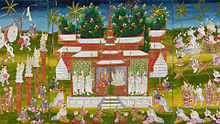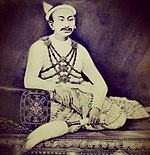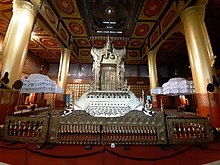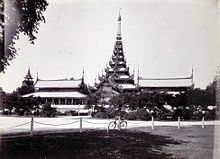
Mindon Min, born Maung Lwin, was the penultimate king of Burma (Myanmar) from 1853 to 1878. He was one of the most popular and revered kings of Burma. Under his half brother King Pagan, the Second Anglo-Burmese War in 1852 ended with the annexation of Lower Burma by the British Empire. Mindon and his younger brother Kanaung overthrew their half brother King Pagan. He spent most of his reign trying to defend the upper part of his country from British encroachments, and to modernize his kingdom.

The Konbaung dynasty, also known as the Third Burmese Empire (တတိယမြန်မာနိုင်ငံတော်), was the last dynasty that ruled Burma/Myanmar from 1752 to 1885. It created the second-largest empire in Burmese history and continued the administrative reforms begun by the Toungoo dynasty, laying the foundations of the modern state of Burma. The reforms, however, proved insufficient to stem the advance of the British, who defeated the Burmese in all three Anglo-Burmese Wars over a six-decade span (1824–1885) and ended the millennium-old Burmese monarchy in 1885. Pretenders to the dynasty claim descent from Myat Phaya Lat, one of Thibaw's daughters.

King Thibaw, also Thebaw or Theebaw, was the last king of the Konbaung dynasty of Burma (Myanmar) and also the last Burmese monarch in the country's history. His reign ended when the armed forces of the Burmese Empire were defeated by the forces of the British Empire in the Third Anglo-Burmese War, on 29 November 1885, prior to its official annexation on 1 January 1886.

Buddhism, specifically Theravāda Buddhism, is the official and state religion of Myanmar since 1961, and practiced by nearly 90% of the population. It is the most religious Buddhist country in terms of the proportion of monks in the population and proportion of income spent on religion. Adherents are most likely found among the dominant Bamar people, Shan, Rakhine, Mon, Karen, and Chinese who are well integrated into Burmese society. Monks, collectively known as the sangha (community), are venerated members of Burmese society. Among many ethnic groups in Myanmar, including the Bamar and Shan, Theravada Buddhism is practiced in conjunction with the worship of nats, which are spirits who can intercede in worldly affairs.

Pagan Min, was the ninth king of the Konbaung dynasty of Burma. Born Maung Biddhu Khyit, he was granted the title of Prince of Pagan by his father Tharrawaddy in August 1842. Pagan Min became king when Tharrawaddy died on 17 November 1846, with the formal title of His Majesty "Sri Pawara Vijaya Nanda Jatha Maha Dharma Rajadhiraja Pagan Min Taya-gyi".
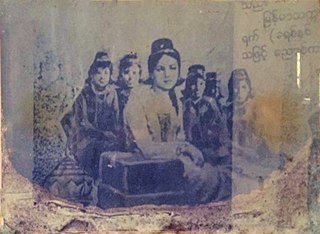
Nanmadaw Me Nu, commonly known by her regnal title Thiri Pavara Mahayazeinda Yadana Dewi was the chief queen of King Bagyidaw of the Konbaung dynasty of Burma from 1819 to 1837. She married Bagyidaw when he was Prince of Sagaing, then became chief queen consort when he ascended to the throne on 5 June 1819, gaining the title Namadaw Mibaya Khaunggyi.

Burmese royal titles are the royal styles that were in use by the Burmese monarchy until the disintegration of the last Burmese monarchy, the Konbaung dynasty, in 1885. These titles were exclusively used by those of royal lineage, or more formally, Maha Zi Maha Thwei (မဟာဆီမဟာသွေး).

The Taunggwin SayadawU Visuddha Silacaraha was the last Buddhist monk to hold the office as Thathanabaing of Burma. The office was abolished after his death in 1938 and no successor was ever appointed.
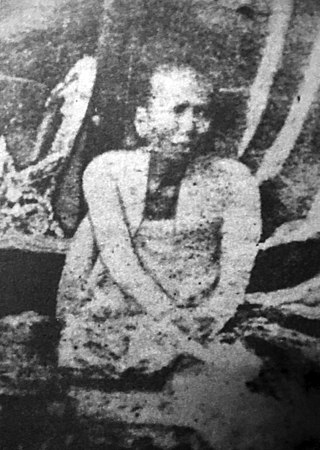
Hsinbyumashin was a senior queen of King Mindon Min during the Konbaung dynasty. She was known for Bronze Hall Massacre. She was the daughter of King Bagyidaw and his consort Nanmadaw Me Nu (Chief Queen of King Bagyidaw). She was one of the most influential queen consorts in Burmese history, and often regarded as the power behind the throne.

Thu Thiri Sanda Wadi, commonly known as the Princess of Taingda, was a royal princess during the Konbaung dynasty. She was also known as a royal goldsmith, renowned for her expertise in working with gems and precious metals; she made jewelry for the royal family.

Thiri Thuriya Yazawadi, commonly known as the Princess of Meikhtila or Meikhtila Supaya Galay, was a royal princess during the Konbaung dynasty. She was born in 1860 at the Mandalay Palace, the daughter of Mindon Min by his consort, Laungshe Mibaya. Her full siblings included two sisters, the Princess of Maing Kaing, Princess of Pakhangyi, and one elder brother, Thibaw Min.
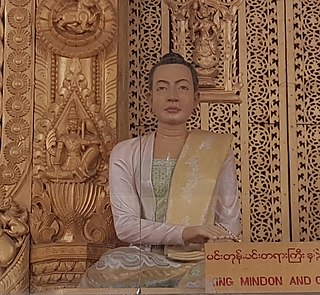
Setkya Dewi, commonly known by her regnal title Thiri Pavara Mahayazeinda Yadana Dewi, was the empress consort and chief wife of King Mindon Min during the Konbaung dynasty. She had strong influence with her husband and was renowned for her knowledge of modern science and astrology. She was popular with the British, who described her as a well-educated woman, and visitors would often bring her gifts related to her astrological interests. She was also known for her extraordinary kindness.
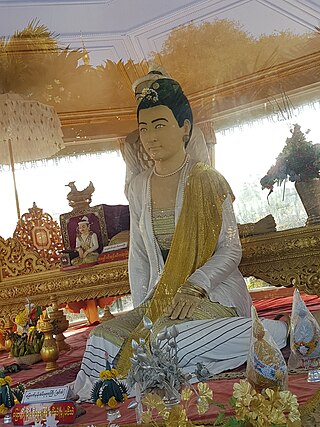
Khin The, commonly known by her regnal title Thiri Maha Yadana Mingala Dewi, was the Queen of the Northern Palace of King Mindon Min during the Konbaung dynasty. Among several queen consorts, Khin The was the favored queen of King Mindon.
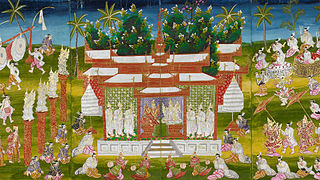
The coronation (Rajabhiseka) was one of the most important rituals of the Burmese Kingdom. Similar to the neighboring countries Thailand, Cambodia and Laos the ceremony is largely influenced by the Indian Hindu Culture. Most of them were typically held in the Burmese month of Kason, but did not necessarily occur during the beginning of a reign. The Sasanalinkaya states that Bodawpaya, like his father, was crowned only after establishing control over the kingdom's administration and purifying the religious institutions. The coronation is then followed by the assumption of the Royal Residence. Following are the rituals done during the coronation of King Mindon on 14 May 1857.
Supaya is the highest royal title for the Burmese royal princesses. The title is given only to the daughters of the Chief Queen, and those of blue-blooded queens. It is said that there were only 8 princesses given the title of Supaya during the reign of King Mindon.

Thiri Thu Sandar Dewi, commonly known as Limban Mibaya, was a queen of the fourth rank of King Mindon during the Konbaung dynasty.

Thu Pabawadi, commonly known as Pyinzi Princess or Pyinzi Supaya, was a high-ranking royal princess of the late Konbaung dynasty.
Prince of Pyinzi was a hereditary title given to the royal prince who was granted the appanage of Pyinzi as liege-lord or myosa, which is equivalent to a duke.

Thiri Thu Yadana Dewi, commonly known as Princess of Mingin or Mingin Supaya, was a high-ranking Burmese royal princess during the late Konbaung dynasty.

Mindon Min, the tenth king of the Konbaung Kingdom, died in Mandalay Palace at the age of 64 on the afternoon of 1 October 1878. A mourning period of seven days preceded his funeral, which took place on 7 October. His son Thibaw was proclaimed the new monarch by the Hluttaw.
